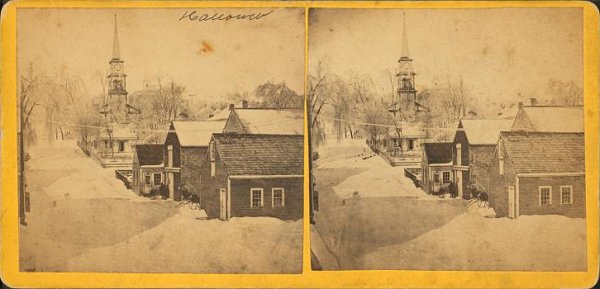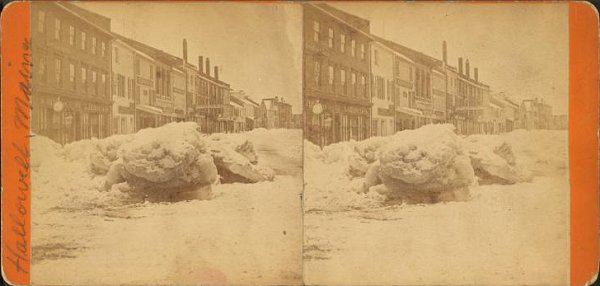Hallowell, Maine (Photographer: A. F. Morse)
Source: New York Public Library
About the Ice Storm:
A storm tracked out of the Plains States to the Great Lakes across the St. Lawrence River Valley and then through Vermont, New Hampshire, and Maine. While cities such as Ottawa, Montreal, and Montpelier received a very heavy snowfall, parts of northern New England farther east, including Maine, suffered from a significant ice storm as the snow changed to rain.
Before reaching the Great Lakes region, the storm likely brought blizzard conditions to the Plains States. In the wake of the snowstorm, it took five days to reopen “the Chicago and Northwestern Railroad from Chicago to Omaha.” At Fremont, Ohio, rain “commenced to fall” at about 9 pm on Saturday, February 13. There, the rain fell heavily at times for 33 hours before coming to an end. At 4:15 Sunday afternoon, “while the rain was falling very fast, and the whole northern and eastern sky was black with storm clouds, the sun shone out with great brilliancy, and soon the outlines of the rainbow were seen, becoming every minute more distinct.” Twenty minutes later, “the sight was one of the most grand and beautiful that the eyes of man could rest upon.” A second rainbow formed to its south and west and both rainbows lasted for “nearly an hour.” The following morning was “cooler” with “a little snow.”
On account of the big snowfall in a winter that was among the snowiest in at least 20 years, the snow in Montreal’s streets was reported to be “eight feet deep and some streets are almost impassable.” By the time the snow stopped falling, Montreal’s seasonal snowfall had reached 118” (38” above any other season during the preceding 20 years).
Farther south and east, snow yielded to rain. At Bangor, “the rain which commenced Monday evening, continued through a large part of the night, during which an amount fell sufficient to thoroughly soak the snow which had previously fallen.” The return of colder air created an icy crust.
Elsewhere in Maine, the freezing rain proved destructive. The February 18, 1869 issue of the National Daily Intelligencer reported:
A despatch from Maine, Tuesday, says: “We had the most severe ice storm last night that has visited this vicinity for years. The scene this morning is beyond description. Hundreds of trees are completely ruined, and the roads are almost impassable.
Later, the Gardiner Journal revealed, “We find that the damage by the late rain, freezing and wind is much greater than we anticipated at first.”
Sources: “In General,” Boston Daily Advertiser, February 15, 1869; Bangor Daily Whig & Courier, February 16, 1869; “Northern Ohio News,” The Daily Cleveland Herald, February 17, 1869; “Slosh!” Bangor Daily Whig & Courier, February 17, 1869; “Great Snow Storm in Canada,” The Daily Cleveland Herald, February 18, 1869; “News Items,” National Daily Intelligencer, February 18, 1869; “Vermont,” Lowell Daily Citizen and News (London), February 20, 1869; and, “Local and Maine Items,” Bangor Daily Whig & Courier, Monday February 22, 1869.

